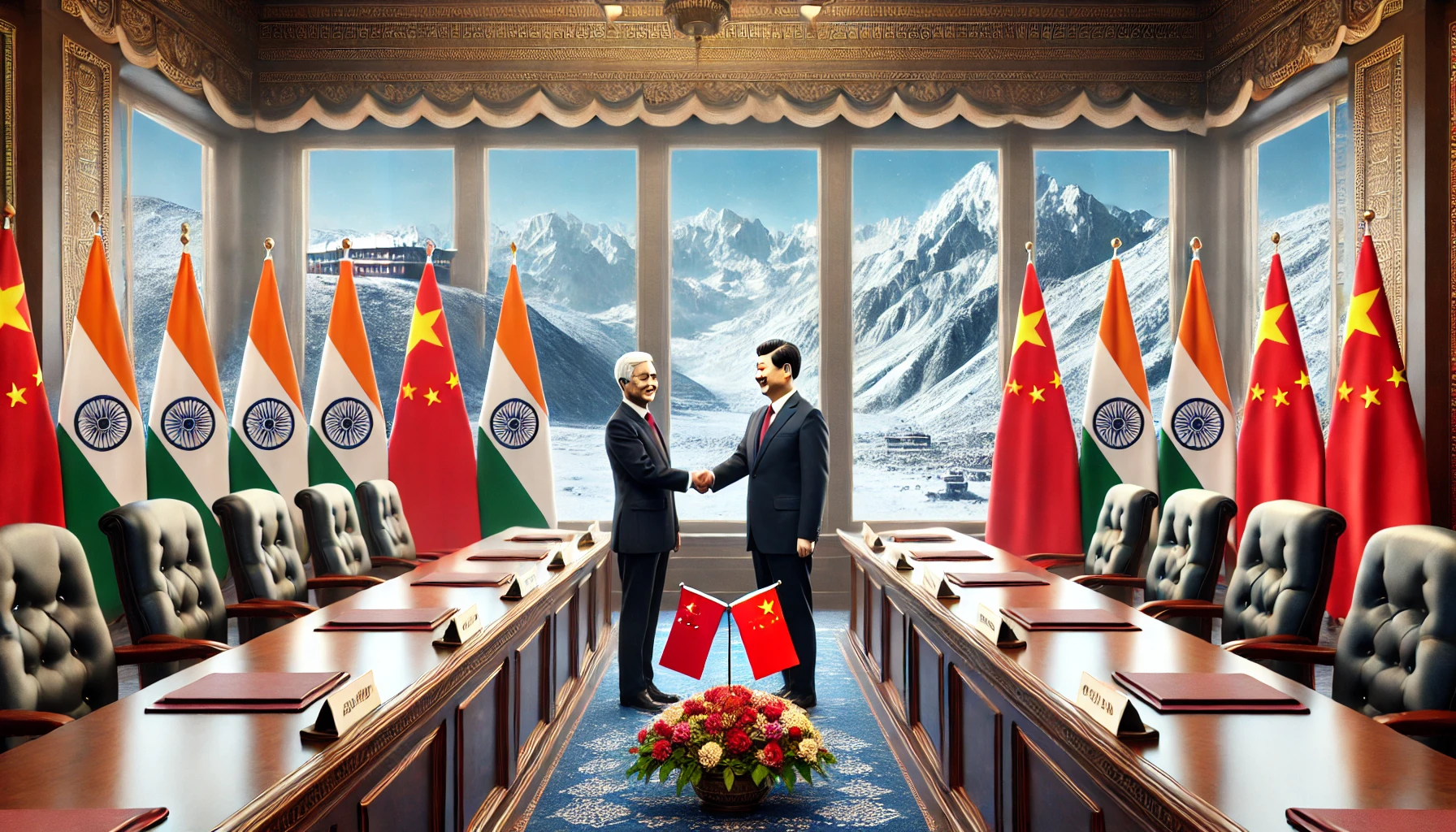India and China have reached a significant agreement concerning military patrols along their contested border in the Himalayan region, a step that could potentially ease tensions that have plagued their relationship since a violent clash in 2020. This new deal, announced by Indian officials on October 21, 2024, seeks to resolve some of the key issues that have contributed to the standoff between the two nuclear-armed neighbors over the past four years.
Background of the Conflict
The roots of the border dispute lie in a long-standing disagreement over the Line of Actual Control (LAC), a 3,488-kilometer (2,167-mile) demarcation that separates the territories held by India and China. This border stretches from the Ladakh region in the west to the eastern Indian state of Arunachal Pradesh, which China claims as part of its Tibet region. The two countries fought a brief war in 1962 over this disputed boundary, but the exact line remains ill-defined and contested, particularly in the rugged and difficult-to-access Himalayan region.
Tensions between the two nations escalated sharply in June 2020, when a violent melee between Indian and Chinese troops in the Galwan Valley resulted in the deaths of 20 Indian soldiers and an undisclosed number of Chinese casualties. This clash marked the worst violence between the two countries in over 50 years and led to a prolonged military standoff, with both nations deploying tens of thousands of troops, as well as tanks, artillery, and fighter jets, to the region.
The Agreement and Its Provisions
The newly announced agreement is the result of several weeks of intense negotiations between Indian and Chinese diplomatic and military officials. Indian Foreign Secretary Vikram Misri said that the deal addresses patrolling arrangements along the LAC, which is designed to lead to the “disengagement and a resolution of the issues that had arisen in 2020.”
This agreement seeks to restore the status quo along the border, resuming patrolling activities that were disrupted after the 2020 clashes. Both sides have agreed to implement a framework that will reduce the possibility of future border confrontations. Misri emphasized that the agreement would allow for disengagement of troops and prevent further escalation of tensions. “Hopefully, we will be able to come back to peace and tranquility,” he stated, highlighting the importance of the deal for regional stability.
Chinese officials confirmed the agreement, with Lin Jian, a spokesperson for China’s Foreign Ministry, stating that “China and India, through diplomatic and military channels, maintained close communication recently over border-related issues. The two sides have now reached a solution.”
Historical Context and Recent Diplomatic Efforts
The border dispute between India and China has been a point of tension for decades, with sporadic confrontations occurring over the years. In 2017, a standoff occurred at the Doklam Plateau, another contested area. However, the 2020 Galwan Valley clash marked a turning point in relations between the two countries, leading to a significant military buildup along the border. Both nations stationed tens of thousands of additional troops in the region, alongside military infrastructure such as roads and outposts.
Since then, several rounds of high-level talks have taken place between the two countries to negotiate the withdrawal of troops from flashpoints like Pangong Lake and the Galwan Valley. However, the disengagement has been slow, and the border remains heavily militarized. According to General Upendra Dwivedi, India’s army chief, the situation on the frontier in the western Himalayas remains sensitive and will continue to be so until the conditions return to what they were before April 2020.

In the wake of the 2020 clash, India strengthened its strategic ties with the United States and other Western nations, particularly in the Indo-Pacific region, as part of efforts to counterbalance China’s growing influence. This rapprochement with the West has been a notable development in India’s foreign policy in recent years. The United States has viewed India as a key partner in its efforts to counter China, though the recent agreement between India and China is likely to be closely watched in Washington.
Political and Geopolitical Implications
The timing of this agreement is particularly significant, as it comes just ahead of the BRICS summit in Russia, where Indian Prime Minister Narendra Modi and Chinese President Xi Jinping are expected to meet. The BRICS group, which originally consisted of Brazil, Russia, India, China, and South Africa, has now expanded to include additional countries such as Iran, Egypt, and Saudi Arabia. The summit, hosted by Russian President Vladimir Putin, is seen as an important diplomatic platform for non-Western powers, and the border agreement between India and China could shape discussions during the event.
The restoration of patrolling rights and the reduction of military tensions along the LAC is viewed by many analysts as a diplomatic success for Modi’s government. Pramit Pal Chaudhuri, an analyst at the Eurasia Group consultancy, suggested that Modi could present the agreement as a significant political victory. “It’s a political success as far as Modi is considered,” Chaudhuri said. “We’ll probably hear him saying, ‘I made the Chinese walk back from what they did in 2020, and few other countries and few other Indian governments have ever accomplished this.’”
However, while the agreement marks progress, some experts caution that it may not lead to a full resolution of all border issues between the two countries. Bharat Karnad, a national security expert at the New Delhi-based Center for Policy Research, noted that China is likely to take a cautious and slow approach to negotiating the specific details of the patrolling agreement. He suggested that it could take years for both sides to fully implement the new framework.
Challenges Ahead
Despite the agreement, there are significant challenges ahead for both India and China. The LAC remains an unstable and poorly defined border, and even with the new deal, incidents of small-scale confrontations are likely to continue. The terrain, high-altitude conditions, and shifting geography of the Himalayas make the border difficult to patrol and prone to misunderstandings.
Additionally, both countries continue to build infrastructure along the border, which could fuel future tensions. China, in particular, has been constructing roads, outposts, and military installations near the LAC, which India views as provocative. At the same time, India has ramped up its infrastructure development in the region to improve mobility for its forces.
However, the latest deal is seen as a critical step in preventing further violence and restoring stability to the region. Analysts believe that the agreement sets the stage for broader negotiations on other contentious issues between India and China, although it may take time for these discussions to bear fruit.
This article is based on the following articles:
https://www.washingtonpost.com/world/2024/10/21/india-china-border-deal-patrol
https://www.nytimes.com/2024/10/22/world/asia/india-china-border.html

Background Information
1. Geography of India and China
India and China are two of the largest countries in the world, both in terms of population and land area. They share a long, mountainous border that stretches across the Himalayas, the world’s highest mountain range. The Himalayas act as a natural barrier between the two countries, but also make the border difficult to define clearly. This unclear border is called the Line of Actual Control (LAC), and it runs for about 3,488 kilometers (2,167 miles).
The border area is located at very high altitudes, often above 4,000 meters (13,000 feet), making it extremely difficult for soldiers to operate there due to freezing temperatures, thin air, and rugged terrain. These harsh conditions make patrolling and defending the border complicated, and also contribute to frequent misunderstandings about where exactly the border lies.
2. What is the Line of Actual Control (LAC)?
The Line of Actual Control (LAC) is the de facto border between India and China. It isn’t an officially agreed-upon boundary like most international borders, but rather a line where each country believes their territory begins. The LAC came into existence after a short war between India and China in 1962, when both sides fought over disputed territories in the Himalayas.
The LAC is divided into three main sectors:
- Western sector: In the region of Ladakh (India) and Aksai Chin (China), this is the area where most recent tensions have occurred.
- Middle sector: This part of the border runs through the states of Himachal Pradesh and Uttarakhand in India.
- Eastern sector: In the region of Arunachal Pradesh, which China claims as part of Tibet.
Due to the lack of clear boundaries and the difficult geography, patrols from both sides sometimes cross into areas claimed by the other, which leads to confrontations.
3. Historical Background of the India-China Border Dispute
India and China have a long history of tension over their border, dating back to the 1950s and 1960s. In 1962, they fought a brief war over the border, which ended with China taking control of a region called Aksai Chin. India still claims Aksai Chin as its own, but China controls it, and this is one of the main sources of tension between the two countries.
In 1962, the war ended in a ceasefire, but the border was never formally agreed upon. As a result, both India and China patrol the LAC with their military forces, and there are frequent disagreements over where the border lies.
Despite these tensions, India and China have maintained diplomatic and economic relations over the years. However, the border issue has always been a major sticking point in their relationship.
4. Why Are the Himalayas Important?
The Himalayan region is important for both India and China for several reasons:
- Strategic location: The high-altitude region gives both countries a vantage point for monitoring each other’s activities. Controlling the mountainous areas is seen as vital for national security.
- Water resources: The Himalayas are the source of several major rivers, including the Indus, Ganges, and Brahmaputra, which provide water for hundreds of millions of people in South Asia. Control of these areas also means control over critical water sources.
5. The 2020 Galwan Valley Clash
The conflict between India and China intensified in June 2020, when a deadly clash occurred in the Galwan Valley, a remote area in the western Himalayas. Indian and Chinese soldiers fought using sticks, stones, and other improvised weapons because they were not allowed to carry guns as part of an earlier agreement to reduce the risk of escalation. At least 20 Indian soldiers and an unknown number of Chinese soldiers were killed in the melee.
This clash was significant because it marked the worst violence between the two countries in over 50 years. After the Galwan Valley incident, both countries sent more troops and military equipment to the region, creating a tense standoff.
6. BRICS and International Relations
The term BRICS refers to a group of five major emerging economies: Brazil, Russia, India, China, and South Africa. These countries meet regularly to discuss global economic and political issues, and they aim to work together to influence world affairs, especially in ways that challenge the dominance of Western countries like the United States and European nations.
The recent agreement between India and China comes just before a major BRICS summit in Russia, where the leaders of these countries will meet. The relationship between India and China is especially important in this group because they are the two largest members and have a lot of influence in Asia.
7. India’s Relationship with the United States
In recent years, India has become an important ally of the United States, particularly in the context of countering China’s growing influence in Asia. The U.S. has strengthened its military and economic ties with India as part of its Indo-Pacific strategy, which is aimed at maintaining peace and stability in the region and countering China’s rise.
After the 2020 clash with China, India deepened its cooperation with the U.S. and other Western nations. However, India also has a complex relationship with Russia, which remains one of its largest suppliers of military equipment. This balancing act between China, the U.S., and Russia makes India’s foreign policy challenging.
8. The Importance of Diplomacy and Military De-escalation
The border issue between India and China is not just about territorial disputes; it also has broader implications for regional and global stability. Both countries have nuclear weapons and large military forces, so any conflict between them could be dangerous not just for Asia but for the entire world. This is why diplomacy—talks between countries to resolve disputes without fighting—is so important.
The recent agreement is an example of diplomacy at work. Military negotiators from both sides have been talking for months to reduce tensions along the border and prevent another violent clash like the one in 2020. Such agreements are crucial for maintaining peace, but they require careful negotiation and trust-building, which can take time.
9. What Does Patrolling Mean?
In the context of the India-China border, patrolling means that soldiers from both countries regularly move along the LAC to monitor activity and make sure their territory is secure. Because the LAC is so long and runs through difficult terrain, patrolling is an essential way for both sides to ensure that the other isn’t building military infrastructure or encroaching on their claimed territory.
The new agreement is expected to restore regular patrols along the LAC, which had been disrupted after the 2020 clashes. Both countries hope that resuming patrols will help to reduce misunderstandings and prevent future incidents.
10. Challenges in Maintaining Peace
Although this new agreement is a positive step toward reducing tensions, the border between India and China remains a sensitive issue. Both countries still have tens of thousands of troops stationed along the LAC, and it will take time to fully implement the new patrolling framework.
Moreover, the LAC is located in a remote, high-altitude region, making it difficult to maintain a stable and well-defined boundary. Conflicts could arise again if either country feels that its territory is being encroached upon.

Debate/Essay Questions
- Can the recent agreement between India and China on border patrols lead to lasting peace between the two countries? Why or why not?
- How should India balance its relationships with both China and the United States, given their ongoing tensions?
Please subscribe to Insight Fortnight, our biweekly newsletter!
